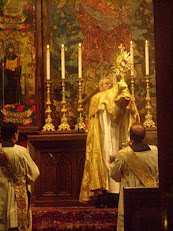POPE Benedict XVI will officially name Australia’s Personal Ordinariate Our Lady of the Southern Cross, under the patronage of St Augustine of Canterbury, on 15 June.
Bishop Peter Elliott, project delegate for the Australian Catholic Bishops Conference and the Congregation for the Doctrine of the Faith, said the name of the Ordinary, the person who will lead the Ordinariate, would also be announced that day.
“The Ordinariate is a national diocese for former Anglicans who will enter full communion with the Catholic Church and yet retain their own heritage and traditions,” Bishop Elliott said.
“Many requests had come from groups to Rome in recent years, that is from Anglicans in the Anglo-Catholic tradition, who were deeply distressed at the ordination of women as priests and bishops and also most unhappy about other liberalising trends in the Anglican Communion.
“They requested that rather than being reconciled to the Church individually they might come to some corporate style of arrangement.
“I would encourage all the Catholics in Melbourne to take an interest in this new venture. It is an historical moment, of course it is small but from small things bigthings grow and I think this will have a remarkable future.”
Two main sources will make up the Ordinariate in Australia: members of the Anglican Church in Australia, the official Anglican denomination; and members of the Anglican Catholic Church in Australia, which is part of the breakaway Traditional Anglican Communion—people who left mainstream Anglicanism for the same reasons that they are now seeking ull communion with the Church.
...
“The Ordinariate is part of the Roman Rite of the Catholic Church; it’s not a distinct rite. It will have the privilege of a liturgy of its own.
“I am a member of the international commission preparing that liturgy. We are preparing a liturgy which draws upon the Roman Rite, the new rite and the old, plus various books of Common Prayer. This liturgy won’t be obligatory but it will be an option.”
Read the entire article at the web site of the Catholic Archdiocese of Melbourne.














"We are preparing a liturgy which draws upon the Roman Rite, THE NEW RITE and the old, plus various books of Common Prayer."
ReplyDelete"the new rite."
There goes the Knott Missal or the Sarum in hierarchic vernacular. So it's the 57 Varieties of the BDW. God help us.
Msgr. Elliott's reputation as a liturgist needs no burnishing from me. The "New Rite" is the Missal of 2002. Elements of this Missal that would be drawn upon, that even a dyed-in-the-wool traditionalist should not have any problem with would include the newly canonized saint's propers and many of the additional prefaces. Even those using the Roman Missal of 1962 are allowed to use the "Gallican" prefaces in addition to the small selection available in the Missal proper.
ReplyDelete